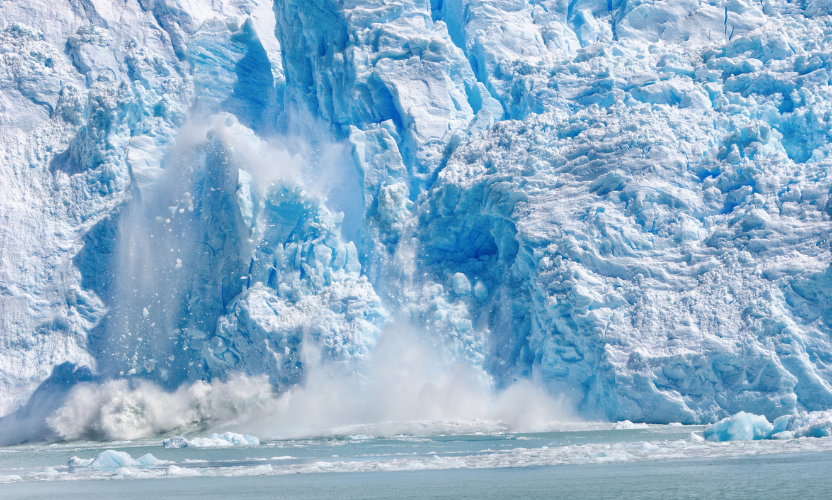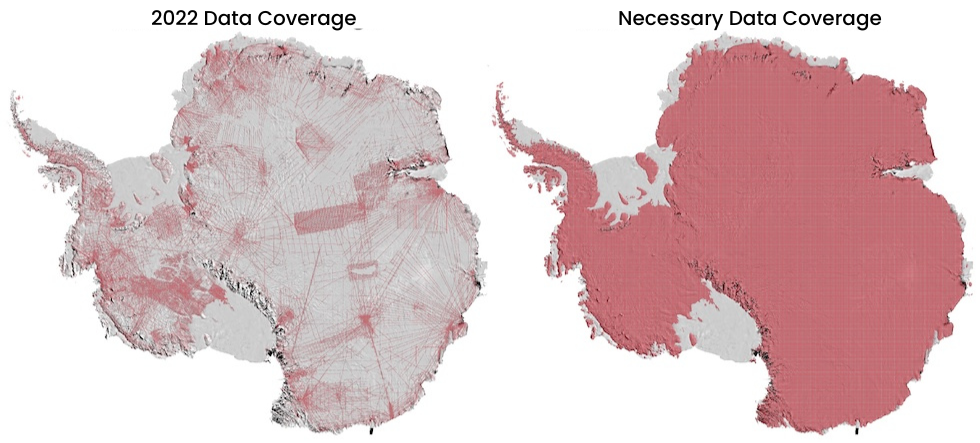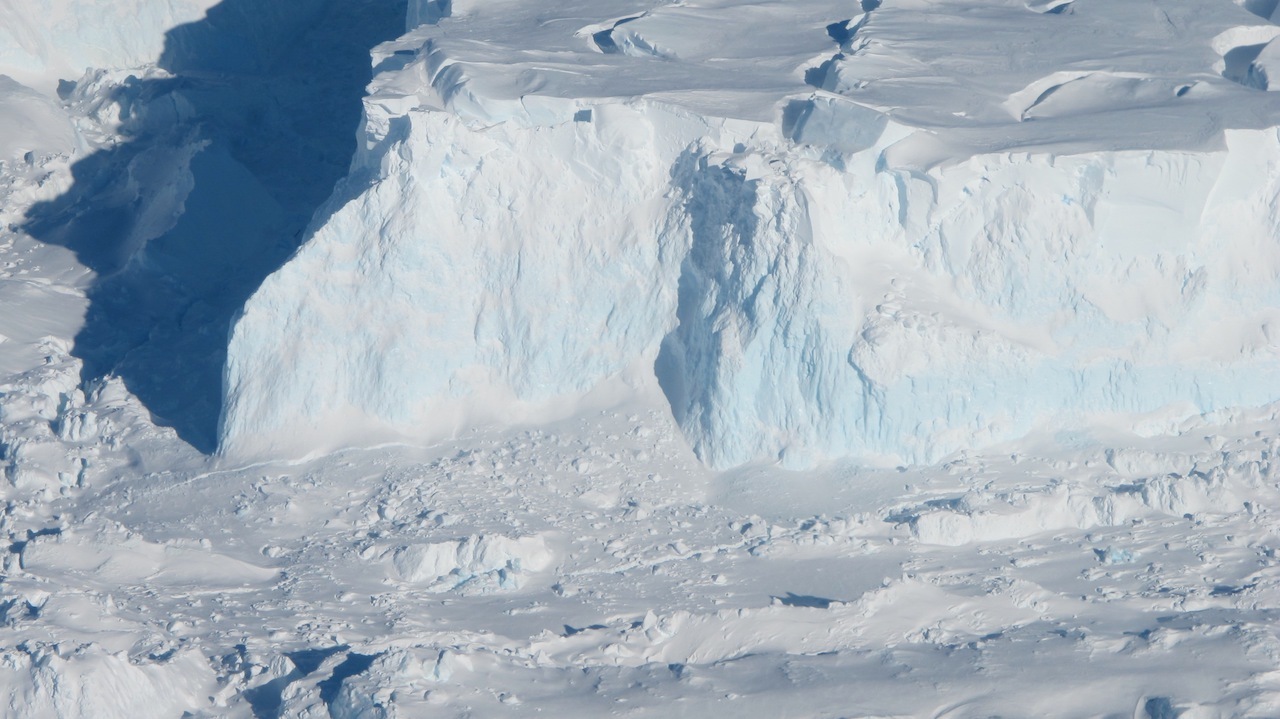
Brief Recap of Thwaites Glacier
Thwaites Glacier, often referred to as the “Doomsday Glacier,” plays a pivotal role in global sea level rise.
Its potential collapse could raise ocean levels by over 3.3 metres (11 feet), significantly destabilising surrounding ice sheets and threatening coastal communities worldwide.
Research Developments Since 2023
Since 2023, advancements in satellite data and ice loss measurements have deepened our understanding of Thwaites’ deterioration.
Underwater mapping has uncovered hidden features that refine predictions about its collapse timeline and the environmental triggers that may accelerate it.
The glacier currently contributes approximately 4% of global sea level rise, losing about 50 billion tonnes of ice annually.
Thwaites is melting faster than expected, intensifying concerns among scientists.
With rising ocean temperatures and increased tidal activity pumping warm seawater beneath the glacier, understanding its collapse is important for climate policy.
Key Research Findings in 2024
Using data from the ICEYE Synthetic Aperture Radar (SAR) satellite constellation, a collaborative initiative between the United States and Finland, researchers have conducted an in-depth examination of the Thwaites Glacier for the first time.
This 2024 satellite data revealed that Thwaites Glacier is losing ice at an accelerating rate compared to previous years.
Advances in imaging techniques have improved tracking of these changes, leading to refined predictions that the glacier could reach a tipping point within the next few decades.
Key findings include:
- The volume of water flowing from Thwaites has more than doubled since the 1990s.
- Ocean warming is identified as a critical factor accelerating melt rates.
- Tidal influences are allowing warm water to infiltrate hidden channels beneath the glacier, further destabilising it.
 Existing data coverage for Antarctica, and the coverage necessary for accurate projections of changes in the decades to come. (Image credit: NASA)
Existing data coverage for Antarctica, and the coverage necessary for accurate projections of changes in the decades to come. (Image credit: NASA)Ongoing Research
Since 2018, a team of scientists known as the International Thwaites Glacier Collaboration has been studying the glacier to gain a better understanding of its potential collapse and timeline.
They utilise ice-breaking ships and autonomous underwater vehicles (AUVs) to explore subglacial areas, providing valuable insights into glacier conditions.
Advancements in Research Methodologies
AI and machine learning have been employed to analyse vast datasets more efficiently, while international efforts have improved data sharing among scientists.
As a result, we better understand the glacier’s behaviour and have improved the accuracy of future predictions.
What Would be the Impact of the Collapse?
Scientists have identified that the glacier is nearing critical thresholds, bringing it closer to a potential tipping point.
- Key triggers include:
- Rising ocean temperatures.
- Weakening ice structures.
These factors could lead to a rapid and irreversible collapse, significantly impacting global sea levels.
| City | Risk Level | Projected Sea Level Rise | Potential Impact |
|---|---|---|---|
| Sydney | High | Up to 3.3m | Flooding of low-lying areas like Bondi and Manly, damage to iconic landmarks like the Opera House, disruption to transportation and infrastructure |
| Melbourne | High | Up to 3.3m | Inundation of bayside suburbs, disruption to the Port of Melbourne, economic losses in tourism and trade |
| Brisbane | High | Up to 3.3m | Flooding of riverside areas, damage to the CBD, disruption to the Port of Brisbane, impacts on the Great Barrier Reef |
| Perth | Moderate | Up to 3.3m | Erosion of beaches like Cottesloe, flooding in low-lying areas, disruption to the Port of Fremantle |
| Adelaide | Moderate | Up to 3.3m | Flooding of the Adelaide coastline, damage to beachfront properties, disruption to the Port of Adelaide |
Global Implications: 2024 Perspective
Revised projections for 2024 show that sea levels could rise significantly within the next decade due to ongoing ice loss from Thwaites.
The collapse would disrupt ocean circulation patterns, altering global climate systems and intensifying weather events. This could result in more extreme storms and shifting rainfall patterns globally.
Policy and Action in Light of 2024 Findings
The findings from 2024 highlight an urgent need for stronger international climate agreements and improved coastal adaptation strategies.
Nations must prioritise updated climate commitments regarding emissions reductions and support for developing countries facing immediate threats from rising seas. Recommended actions include:
- Implementing infrastructure reinforcements.
- Investing in nature-based solutions.
- Allocating resources for enhanced satellite monitoring and field research.
Future Research Directions
Looking ahead to upcoming expeditions and projects for 2025, researchers will focus on gaining deeper insights into Thwaites Glacier’s dynamics and its global impact. Key areas requiring further investigation include:
- The glacier’s underlying geology.
- Ice-sheet behaviour.
- Potential tipping points for collapse.
Advancing this research will necessitate cutting-edge technology such as enhanced satellite systems and improved climate modelling tools to provide accurate predictions.
Impact and the Path Forward
The discoveries made in 2024 reaffirm Thwaites Glacier’s important role in global sea-level rise, revealing accelerated melting and destabilisation. As our understanding evolves, it becomes clear that Thwaites is approaching tipping points that could significantly impact coastal regions worldwide.
This calls for an urgent approach to climate policy where research informs international agreements and drives decisive action to mitigate potential consequences.
Governments, scientists, and global leaders must collaborate to address these findings effectively, ensuring a sustainable future for all.
Join us in our fight against climate change!
If you want to learn more about climate change and how we can help you become part of the solution, please contact us today.
We offer a range of services that can help you reduce your carbon footprint and contribute to a greener future.
Whether you need a carbon audit or carbon neutral certification, together we can make a difference for our planet and our future generations.



